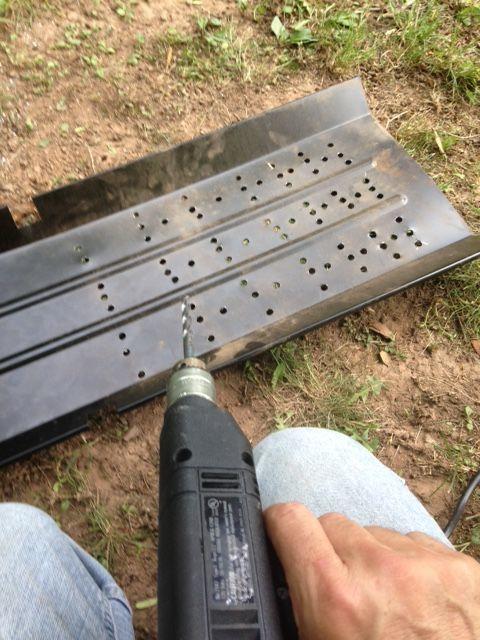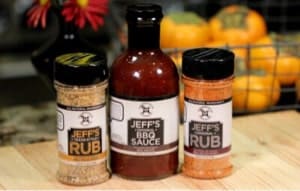- Jun 6, 2016
- 15
- 18
Hello, everybody. I've been an avid smoker for about 14 years now.
I'm originally an Okie. A lifetime in that state will give a person a taste for barbecue. (Wild Horse Mountain Barbecue between Sallisaw and Poteau; Slick's Barbecue in Muskogee; Tom's Oaklawn Barbecue at NE 10th Street and I-35 in OKC; Jack's Barbecue on Britton Road in The Village, just to name a few of the spots I kept on my regular route back in the '80s and '90s. I also developed an appreciation for Bryant's Barbecue during my college years in Kansas City.)
In 2000, we moved to Northern California. There was good barbecue to be had, but you had to drive a good ways to get it. That was when I decided it was time for me to learn how to do my own barbecue.
After a little reading, I went with a Weber kettle grill, using charcoal baskets to keep the fire off to the side. I made a number of really delicious pulled pork roasts, following the guidance and recipes in Elder Ward's Pulled Pork Treatise. One Thanksgiving, I smoked a 12-pound turkey. I made any number of beer can chickens, and smoked an endless number of fresh, wild-caught salmon fillets.
I moved to New York City in 2006. NYC has a surprising number of really excellent barbecue joints, including three standouts within walking distance of our apartment: Fletcher's, on 3rd Avenue between 8th & 9th streets; Hometown Barbecue, deep down in Red Hook; and Hill Country on Fulton Mall. The latter two have true Texas bona fides. They smoke with post oak. If you wear a Franklin Barbecue t-shirt in, you get a hearty greeting. If you mention the Mueller family (one of Texas' barbecue dynasties) the pitmasters at both places will assure you that they know the Muellers.
But I still love to smoke my own. In Brooklyn, I content myself with my little Weber Go-Anywhere smoker. It has proper ventilation, and is big enough to do a dandy job on a salmon fillet or a pork tenderloin.
When I first got to NYC, I boasted to my co-workers that I was something of a hand at smoking meat. They decided I should put my money where my mouth is. We chipped in on a Weber kettle grill and installed it in a teammate's backyard in NJ. That first barbecue became an annual tradition.
For the first several years, it was just the handful of folks on my team and their families; about 15, 20 people. Then, one of my teammates (the one where the smoker stays) left my employer and moved to another NYC outfit. With her co-workers from the new outfit, plus a few neighbors, the annual event has swelled to 45 or 50 folks. We "inherited" another Weber kettle grill and a Brinkman cabinet smoker.
The cabinet came from a co-worker who had gotten frustrated with its inability to cook effectively, and given up on it. I did a little reading and learned that drilling a bunch of holes in the charcoal pan affords better draft. I also filled the water pan with sand, to help disseminate the heat more evenly. Without any further modifications, the little cabinet smoker has shown itself to do a dandy job at smoking baby back ribs.
This year, our host is tacking her daughter's high school graduation party onto the annual barbecue event. We're expecting somewhere in the neighborhood of 75 folks.
We decided it was high time we got a cheap offset smoker. We went for the Char-Broil 1280. I had bought the smaller version of the Char-Broil offset smoker a few years ago for our mom's 80th birthday party. Without making any modifications, I produced a good pulled pork shoulder and on another occasion a decent batch of baby backs.
I figured one stamped metal smoker was about the same as another.
We got pretty much what we paid for with the thing -- no surprise there. I've been reading here and elsewhere about modifications for a large COS. The advice I've received has been excellent, and much appreciated. I sanded the thing down and gave it a couple of coats of Rust-Oleum High-Heat Ultra. (Couldn't find any Krylon). I used RTV silicone gasket maker to join the two halves of the fire box, to put a gasket around the fire box door, to put a seal between the smokestack flashing and the cook chamber; and to get a better seal around the cook chamber door.
One of the biggest problems with the Char-Broil 1280 is the huge gap in back between the upper and lower halves of the cook chamber. I glued several layers of Nomex gasket material into the space with RTV. Not sure how long it will hold up, but it should last through this year's big event.
For now, I'm not going to try to fabricate a hefty steel baffle; maybe next year. I've read about people getting good results using cut-up heavy-duty foil pans as baffles.
The 1280 comes with a shaped steel tray designed to hang from the grills to support charcoal for direct grilling. My friends have a gas grill, and will never need to use the COS for grilling. I drilled a bunch of holes in the charcoal tray. Inverted, it makes, I hope, a pretty good heat channel, and mates up nicely with a cut-to-fit aluminum pan for a baffle. If needed, I'll add some pavers or sand pans to help with heat distribution.
I did the seasoning burn this weekend. I used a couple of the Weber charcoal baskets to hold the charcoal, and they worked great. I fired up a chimney full of charcoal added several chunks of hickory (as an Okie, my favorite smoking wood). The fire pegged the cheap, manufacturer-issued thermometer within 15-20 minutes, then backed slowly down to about 250, where it held for three or so hours, and then gently cooled down over the next several hours.
I didn't use the baffle or steel tray during the burn-in. I also forgot my add-on thermometers, so I don't have a clear idea yet what's going on at cooking level. If two baskets pegged the factory thermometer, I imagine one basket, fed a few more coals once an hour, ought to be about right. I'll install the add-on thermometers next weekend and then do a test cook on a rack of ribs and a picnic shoulder.
I'm originally an Okie. A lifetime in that state will give a person a taste for barbecue. (Wild Horse Mountain Barbecue between Sallisaw and Poteau; Slick's Barbecue in Muskogee; Tom's Oaklawn Barbecue at NE 10th Street and I-35 in OKC; Jack's Barbecue on Britton Road in The Village, just to name a few of the spots I kept on my regular route back in the '80s and '90s. I also developed an appreciation for Bryant's Barbecue during my college years in Kansas City.)
In 2000, we moved to Northern California. There was good barbecue to be had, but you had to drive a good ways to get it. That was when I decided it was time for me to learn how to do my own barbecue.
After a little reading, I went with a Weber kettle grill, using charcoal baskets to keep the fire off to the side. I made a number of really delicious pulled pork roasts, following the guidance and recipes in Elder Ward's Pulled Pork Treatise. One Thanksgiving, I smoked a 12-pound turkey. I made any number of beer can chickens, and smoked an endless number of fresh, wild-caught salmon fillets.
I moved to New York City in 2006. NYC has a surprising number of really excellent barbecue joints, including three standouts within walking distance of our apartment: Fletcher's, on 3rd Avenue between 8th & 9th streets; Hometown Barbecue, deep down in Red Hook; and Hill Country on Fulton Mall. The latter two have true Texas bona fides. They smoke with post oak. If you wear a Franklin Barbecue t-shirt in, you get a hearty greeting. If you mention the Mueller family (one of Texas' barbecue dynasties) the pitmasters at both places will assure you that they know the Muellers.
But I still love to smoke my own. In Brooklyn, I content myself with my little Weber Go-Anywhere smoker. It has proper ventilation, and is big enough to do a dandy job on a salmon fillet or a pork tenderloin.
When I first got to NYC, I boasted to my co-workers that I was something of a hand at smoking meat. They decided I should put my money where my mouth is. We chipped in on a Weber kettle grill and installed it in a teammate's backyard in NJ. That first barbecue became an annual tradition.
For the first several years, it was just the handful of folks on my team and their families; about 15, 20 people. Then, one of my teammates (the one where the smoker stays) left my employer and moved to another NYC outfit. With her co-workers from the new outfit, plus a few neighbors, the annual event has swelled to 45 or 50 folks. We "inherited" another Weber kettle grill and a Brinkman cabinet smoker.
The cabinet came from a co-worker who had gotten frustrated with its inability to cook effectively, and given up on it. I did a little reading and learned that drilling a bunch of holes in the charcoal pan affords better draft. I also filled the water pan with sand, to help disseminate the heat more evenly. Without any further modifications, the little cabinet smoker has shown itself to do a dandy job at smoking baby back ribs.
This year, our host is tacking her daughter's high school graduation party onto the annual barbecue event. We're expecting somewhere in the neighborhood of 75 folks.
We decided it was high time we got a cheap offset smoker. We went for the Char-Broil 1280. I had bought the smaller version of the Char-Broil offset smoker a few years ago for our mom's 80th birthday party. Without making any modifications, I produced a good pulled pork shoulder and on another occasion a decent batch of baby backs.
I figured one stamped metal smoker was about the same as another.
We got pretty much what we paid for with the thing -- no surprise there. I've been reading here and elsewhere about modifications for a large COS. The advice I've received has been excellent, and much appreciated. I sanded the thing down and gave it a couple of coats of Rust-Oleum High-Heat Ultra. (Couldn't find any Krylon). I used RTV silicone gasket maker to join the two halves of the fire box, to put a gasket around the fire box door, to put a seal between the smokestack flashing and the cook chamber; and to get a better seal around the cook chamber door.
One of the biggest problems with the Char-Broil 1280 is the huge gap in back between the upper and lower halves of the cook chamber. I glued several layers of Nomex gasket material into the space with RTV. Not sure how long it will hold up, but it should last through this year's big event.
For now, I'm not going to try to fabricate a hefty steel baffle; maybe next year. I've read about people getting good results using cut-up heavy-duty foil pans as baffles.
The 1280 comes with a shaped steel tray designed to hang from the grills to support charcoal for direct grilling. My friends have a gas grill, and will never need to use the COS for grilling. I drilled a bunch of holes in the charcoal tray. Inverted, it makes, I hope, a pretty good heat channel, and mates up nicely with a cut-to-fit aluminum pan for a baffle. If needed, I'll add some pavers or sand pans to help with heat distribution.
I did the seasoning burn this weekend. I used a couple of the Weber charcoal baskets to hold the charcoal, and they worked great. I fired up a chimney full of charcoal added several chunks of hickory (as an Okie, my favorite smoking wood). The fire pegged the cheap, manufacturer-issued thermometer within 15-20 minutes, then backed slowly down to about 250, where it held for three or so hours, and then gently cooled down over the next several hours.
I didn't use the baffle or steel tray during the burn-in. I also forgot my add-on thermometers, so I don't have a clear idea yet what's going on at cooking level. If two baskets pegged the factory thermometer, I imagine one basket, fed a few more coals once an hour, ought to be about right. I'll install the add-on thermometers next weekend and then do a test cook on a rack of ribs and a picnic shoulder.







